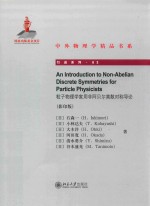

粒子物理学家用非阿贝尔离散对称导论=aN lntroduction to Non Abelian Discrete Symmetries for Particle PhysicistsPDF电子书下载
- 电子书积分:20 积分如何计算积分?
- 作 者:黄清俊
- 出 版 社:
- 出版年份:2014
- ISBN:
- 页数:0 页
1 Introduction 1
References 3
2 Basics of Finite Groups 13
References 20
3 SN 21
3.1 S3 21
3.1.1 Conjugacy Classes 21
3.1.2 Characters and Representations 22
3.1.3 Tensor Products 22
3.2 S4 25
3.2.1 Conjugacy Classes 27
3.2.2 Characters and Representations 27
3.2.3 Tensor Products 29
References 30
4 AN 31
4.1 A4 31
4.2 A5 34
4.2.1 Conjugacy Classes 35
4.2.2 Characters and Representations 35
4.2.3 Tensor Products 37
References 41
5 T′ 43
5.1 Conjugacy Classes 43
5.2 Characters and Representations 44
5.3 Tensor Products 47
6 DN 51
6.1 DN with N Even 51
6.1.1 Conjugacy Classes 52
6.1.2 Characters and Representations 52
6.1.3 Tensor Products 54
6.2 DN with N Odd 56
6.2.1 Conjugacy Classes 56
6.2.2 Characters and Representations 56
6.2.3 Tensor Products 57
6.3 D4 58
6.4 D5 59
7 QN 61
7.1 QN with N=4n 61
7.1.1 Conjugacy Classes 62
7.1.2 Characters and Representations 62
7.1.3 Tensor Products 62
7.2 QN with N=4n+2 64
7.2.1 Conjugacy Classes 64
7.2.2 Characters and Representations 64
7.2.3 Tensor Products 65
7.3 Q4 66
7.4 Q6 67
8 QD2N 69
8.1 Generic Aspects 69
8.1.1 Conjugacy Classes 70
8.1.2 Characters and Representations 70
8.1.3 Tensor Products 71
8.2 QD16 72
9 ∑(2N2) 75
9.1 Generic Aspects 75
9.1.1 Conjugacy Classes 75
9.1.2 Characters and Representations 76
9.1.3 Tensor Products 77
9.2 ∑(18) 78
9.3 ∑(32) 80
9.4 ∑(50) 84
10 △(3N2) 87
10.1 △(3N2) with N/3≠Integer 87
10.1.1 Conjugacy Classes 88
10.1.2 Characters and Representations 89
10.1.3 Tensor Products 89
10.2 △(3N2) with N/3 Integer 91
10.2.1 Conjugacy Classes 91
10.2.2 Characters and Representations 92
10.2.3 Tensor Products 93
10.3 △(27) 94
References 95
11 TN 97
11.1 Generic Aspects 97
11.1.1 Conjugacy Classes 98
11.1.2 Characters and Representations 99
11.1.3 Tensor Products 99
11.2 T7 100
11.3 T13 102
11.4 T19 104
References 108
12 ∑(3N3) 109
12.1 Generic Aspects 109
12.1.1 Conjugacy Classes 110
12.1.2 Characters and Representations 111
12.1.3 Tensor Products 112
12.2 ∑(81) 113
References 121
13 △(6N2) 123
13.1 △(6N2)with N/3≠Integer 123
13.1.1 Conjugacy Classes 123
13.1.2 Characters and Representations 126
13.1.3 Tensor Products 128
13.2 △(6N2) with N/3 Integer 131
13.2.1 Conjugacy Classes 131
13.2.2 Characters and Representations 133
13.2.3 Tensor Products 134
13.3 △(54) 138
13.3.1 Conjugacy Classes 138
13.3.2 Characters and Representations 139
13.3.3 Tensor Products 141
References 145
14 Subgroups and Decompositions of Multiplets 147
14.1 S3 147
14.1.1 S3→Z3 148
14.1.2 S3→Z2 148
14.2 S4 149
14.2.1 S4→S3 150
14.2.2 S4→A4 151
14.2.3 S4→∑(8) 151
14.3 A4 152
14.3.1 A4→Z3 152
14.3.2 A4→Z2×Z2 153
14.4 A5 153
14.4.1 A5→A4 153
14.4.2 A5→D5 153
14.4.3 A5→S3?D3 154
14.5 T′ 154
14.5.1 T′→Z6 154
14.5.2 T′→Z4 155
14.5.3 T′→Q4 155
14.6 General DN 155
14.6.1 DN→Z2 156
14.6.2 DN→ZN 157
14.6.3 DN→DM 157
14.7 D4 158
14.7.1 D4→Z4 158
14.7.2 D4→Z2×Z2 159
14.7.3 D4→Z2 159
14.8 General QN 159
14.8.1 QN→Z4 160
14.8.2 QN→ZN 161
14.8.3 QN→QM 161
14.9 Q4 162
14.9.1 Q4→Z4 162
14.10 QD2N 162
14.10.1 QD2N→Z2 163
14.10.2 QD2N→ZN 163
14.10.3 QD2N→DN/2 163
14.11 General∑(2N2) 164
14.11.1 ∑(2N2)→Z2N 164
14.11.2 ∑(2N2)→ZN×ZN 164
14.11.3 ∑(2N2)→DN 165
14.11.4 ∑(2N2)→QN 166
14.11.5 ∑(2N2)→∑(2M2) 166
14.12 ∑(32) 167
14.13 General △(3N2) 168
14.13.1 △(3N2)→Z3 169
14.13.2 △(3N2)→ZN×ZN 169
14.13.3 △(3N2)→TN 170
14.13.4 △(3N2)→△(3M2) 170
14.14 △(27) 172
14.14.1 △(27)→Z3 172
14.14.2 △(27)→Z3×Z3 172
14.15 General TN 173
14.15.1 TN→Z3 173
14.15.2 TN→ZN 173
14.16 T7 174
14.16.1 T7→Z3 174
14.16.2 T7→Z7 175
14.17 General ∑(3N3) 175
14.17.1 ∑(3N2)→ZN×ZN×ZN 175
14.17.2 ∑(3N3)→△(3N2) 175
14.17.3 ∑(3N3)→∑(3M3) 176
14.18 ∑(81) 176
14.18.1 ∑(81)→Z3×Z3×Z3 177
14.18.2 ∑(81)→△(27) 177
14.19 General△(6N2) 178
14.19.1 △(6N2)→∑(2N2) 179
14.19.2 △(6N2)→△(3N2) 180
14.19.3 △(6N2)→△(6M2) 180
14.20 △(54) 181
14.20.1 △(54)→S3×Z3 182
14.20.2 △(54)→∑(18) 182
14.20.3 △(54)→△(27) 183
15 Anomalies 185
15.1 Generic Aspects 185
15.2 Explicit Calculations 189
15.2.1 53 189
15.2.2 S4 190
15.2.3 A4 190
15.2.4 A5 191
15.2.5 T′ 192
15.2.6 DN (N Even) 193
15.2.7 DN (N Odd) 194
15.2.8 QN(N=4n) 194
15.2.9 QN(N=4n+2) 195
15.2.10 QD2N 196
15.2.11 ∑(2N2) 197
15.2.12 △(3N2)(N/3≠Integer) 198
15.2.13 △(3N2)(N/3 Integer) 199
15.2.14 TN 200
15.2.15 ∑(3N3) 201
15.2.16 △(6N2)(N/3≠Integer) 202
15.2.17 △(6N2)(N/3 Integer) 203
15.3 Comments on Anomalies 203
References 204
16 Non-Abellan Discrete Symmetry in Quark/Lepton Flavor Models 205
16.1 Neutrino Flavor Mixing and Neutrino Mass Matrix 205
16.2 A4 Flavor Symmetry 207
16.2.1 Realizing Tri-Bimaximal Mixing of Flavors 207
16.2.2 Breaking Tri-Bimaximal Mixing 209
16.3 S4 Flavor Model 211
16.4 Alternative Flavor Mixing 219
16.5 Comments on Other Applications 222
16.6 Comment on Origins of Flavor Symmetries 223
References 224
Appendix A Useful Theorems 229
References 235
Appendix B Representations of S4 in Different Bases 237
B.1 Basis Ⅰ 237
B.2 Basis Ⅱ 238
B.3 Basis Ⅲ 240
B.4 Basis Ⅳ 242
References 244
Appendix C Representations of A4 in Different Bases 245
C.1 Basis Ⅰ 245
C.2 Basis Ⅱ 245
References 246
Appendix D Representations of A5 in Different Bases 247
D.1 Basis Ⅰ 247
D.2 Basis Ⅱ 253
References 259
Appendix E Representations of T'in Different Bases 261
E.1 Basis Ⅰ 262
E.2 Basis Ⅱ 263
References 264
Appendix F Other Smaller Groups 265
F.1 Z4?Z4 265
F.2 Z8?Z2 268
F.3 (Z2×Z4)?Z2(Ⅰ) 270
F.4 (Z2×Z4)?Z2(Ⅱ) 272
F.5 Z3?Z8 275
F.6 (Z6×Z2)?Z2 277
F.7 Z9?Z3 281
References 283
Index 285
- 《新编高中物理竞赛教程习题全解》钟小平主编;钟小平,倪国富,曹海奇编写 2019
- 《物联网导论》张翼英主编 2020
- 《数学物理方法与仿真 第3版》杨华军 2020
- 《材料导论》张会主编 2019
- 《化工传递过程导论 第2版》阎建民,刘辉 2020
- 《中学物理奥赛辅导:热学 光学 近代物理学》崔宏滨 2012
- 《长江口物理、化学与生态环境调查图集》于非 2019
- 《大学物理简明教程 下 第2版》施卫主编 2020
- 《慢性呼吸系统疾病物理治疗工作手册》(荷)瑞克·考斯林克(RikGosselink) 2020
- 《医学物理学》洪洋 2020
